Nepal has a long and rich history of jewelry that is deeply connected to the culture, traditions, and identity of the country. In Nepal, people have been wearing ornaments for centuries and its entirety has been associated with Nepalese culture and spirituality. Jewelry in Nepal has never just been a fashion statement; it has deeper meanings associated with social status, religious beliefs, and ethnic origin.
The earliest versions of Nepali jewelry were made from natural materials, such as bones, stones, shells, woods, and even seeds. Ornaments transitioned to precious pieces like gold, silver, and copper as the art of metalworking developed. Nepali jewelry designs revolve around meaningful symbols, patterns, and motifs that represent some aspect of spiritual or cultural value. This form of art and creation has occurred throughout history, and handmade jewelry of Nepal continues to use manual tools and techniques to date.
.jpg)
There are many ethnic communities in Nepal, each with its own traditional jewelry, which illustrates the country's cultural diversity. The Newar community has lots of intricate silver and gold work, often related to rituals and religious activity. The Tharu community wears significant silver and bead jewelry made from natural materials. Each of the Gurung, Magar, Rai, and Limbu communities has its unique jewelry styles linked to their cultural marriage practices and festivals. Such diversity shows that Nepali ornaments are closely bound with people's own identities and their community's traditions.
Jewelry in Nepal has an important role in ceremonies and life events. From weddings to religious festivals to rites of passage, jewelry acts as a symbol for prosperity, protection, and blessing. Some jewelry, such as tilhari (the necklace married women must wear), phuli (nose ring), sirbandi (forehead ornament), or bangles, is a statement piece of social and spiritual meaning. Many designs feature Hindu and Buddhist symbols, such as the lotus, vajra, and conch, meant to signify luck or dispel negative energy.
Jewelries of Major Communities of Nepal
Newar Traditional Jewelry
The Newar community of Kathmandu Valley has one of the richest traditions of jewelry making in Nepal. Skilled Newar goldsmiths and silversmiths have been respected for centuries and were even invited by rulers of Nepal and Tibet to design ornaments, coins, and religious statuettes. For Newari women, jewelry is more than just personal adornment. It signifies one's cultural identity, family background, status, and religious beliefs. Children often wear small earrings, some silver ornaments, and protective amulets, and older girls get to wear larger, heavier, and more elaborate designs.
Today, traditional Newar bridal jewelry is still used in weddings and other ceremonies. The statue of King Bhupatindra’s bride at the Changunarayan Temple, built in the 17th century, displays many ornaments still worn at the present time, such as a crown of gold flowers, coral and tayo necklaces, amulet containers, a snake necklace for kumai, ear studs, rings, cuffs, chains, and silver anklets.
| Categories | Names | Description |
|---|
| Head Jewelry | Lunswan, Nyapu Shikha, Sheerbandi, Sathwacha | Lunswan is a customary Newar gold necklace worn by married women and signifies prosperity and faith. The Nyapu Shikha, worn during festivals and ceremonies, is a five-row golden head ornament signifying five elements(earth, water, fire, air, space). The Sheerbandi is a forehead piece tied to the hair and found mainly in weddings and rituals. The Sathwacha is a silver hair ornament with fish-shaped and bell-like hangings worn mostly by girls during the Ihi and Barah ceremonies. |
| Ear ornaments | Makansi, Tuki | Makansi are U-shaped gold or silver earrings that signify beauty and culture. Tuki are double studs which are worn in the ear helix, usually worn by elderly women after rituals. |
Rings and Hand Ornaments | Pyakhan Aangu, Ashrafiya Aangu, Hina Angu | The Pyakhan Aangu is a smooth silver ring, worn on the index finger for weddings and dances. The Ashrafiya Aangu is a ring in which a gold coin is placed on top, and this ring is only worn during times of festivals. The Hina Angu is a snake-shaped ring that is specifically designed to look neat and stylish. |
| Necklaces | Tayo, Tikma, Jantar, Ghau, Muga mala (Pearl Necklace) | The Tikma is a broad red cloth necklace with added gold plates and green stones worn at wedding ceremonies or traditional dances. The Jantar is a square amulet pendant worn around the neck for protection or good fortune, decorated with auspicious symbols. The Ghau is an amulet box pendant with stones representing the Pancha Buddhas in Tibetan style. |
| Foot Ornaments | Kalli, Sinhakhwa Kalli, Jangi Selaya Kalli | The Tayo is a long gold necklace worn by brides and deities, signifying the Kathmandu Valley and Swayambhu Stupa. The Tikma is a wide red cloth necklace covered with gold plates and green gemstones worn by the bride during weddings and traditional dances. The Jantar is a square amulet pendant carried as a protective talisman for luck and prosperity, decorated with auspicious symbols. The Ghau is an amulet box pendant in the Tibetan style, decorated with stones representing the Pancha Buddhas. |
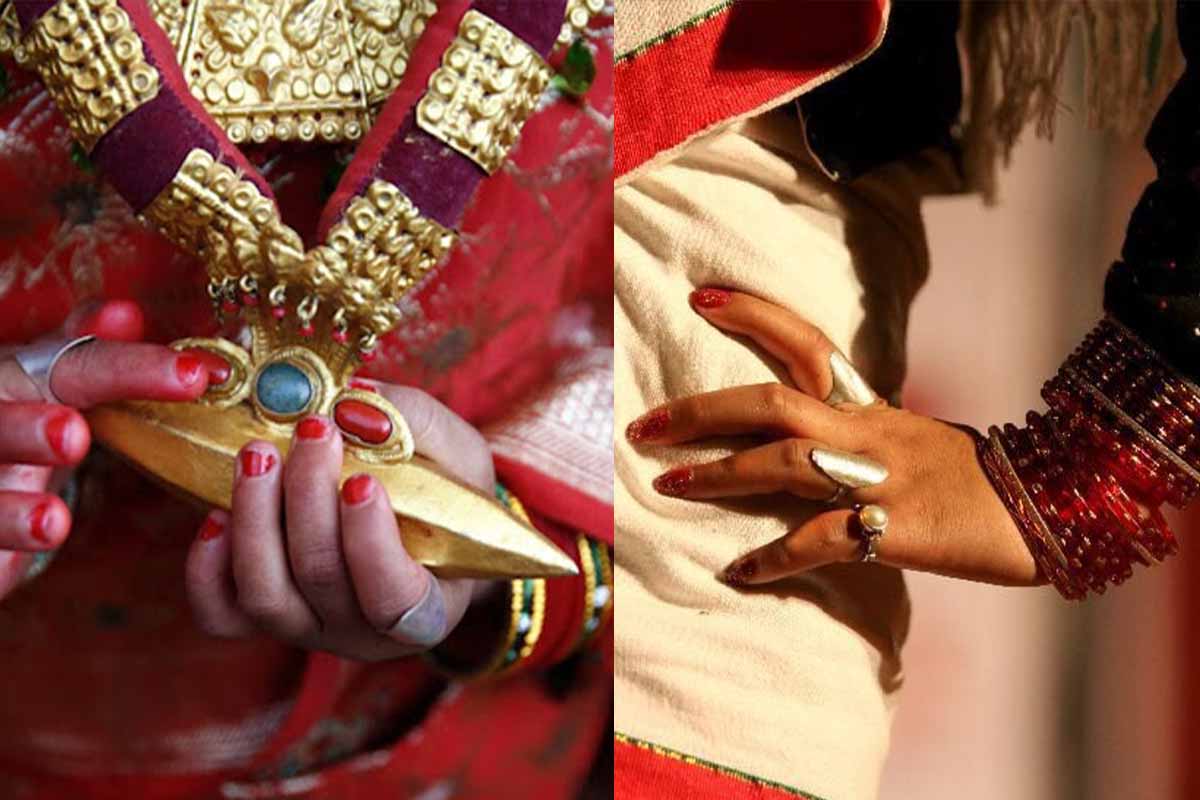
Magar and Gurung Jewelry Traditions
Jewelry traditions of the Magar and Gurung communities of Nepal showcase their rich culture, status, and spirituality. Women wear jewelry proudly to make a statement, particularly at events like festivals and weddings. Necklaces consist of silver and beads or semi-precious stones, and earring designs range from simple studs to bulky pendants. Some necklaces or earrings contain beads made from coral, turquoise, and amber, which have protective and symbolic meanings. Bracelets, armlets, and waist belts are popular, with engraved patterns or spiritual symbols. Artisans can craft each piece because of their skilled knowledge of traditional metalworking and bead-stringing techniques to create ample options. The use of Magar and Gurung jewelry is to celebrate heritage and mark identity while also grounding wearers in their ancestral beliefs, unique to the Himalayan region.
| Categories | Name | Description |
|---|
| Head Jewelry | Sirbandi, Sirphul, Chandra, Ghalek, Tiki, Mujetro | Sirbandi is a traditional forehead band, often decorated with intricate beadwork, embroidery and sometimes stones, that often has three horizontal stripes or bands. Sirphuli is a gold or silver forehead ornament that sits on the forehead with Sirbandi. Chandrama is a crescent or circular-shaped ornament representing the moon. Ghalek is a decorated headband made with beads or embroidery. Tiki is a small black triangular piece worn on the forehead. Mujetro is a shawl covering to complete the traditional attire. |
| Ear and nose ornaments | Madwari, Bulaki, Phuli, Gokkul | Madwari are earrings traditionally worn, while Bulaki is a nose ornament comprising a ring and a pendant that swings just below the nose near the lips. Phuli is a nose ring that is applied to the left nostril. Gokkul are earrings that are made of silver or gold and hang from the edges of the earlobes, and they are mainly an ornament for males. |
Neck Jewelry | Haari, Pote, Kantha, Naugedi, Jantar | Haari is made of many silver coins, usually vintage or antique coins, sewn together with a silver string or chain. Pote is a necklace made with yellow and green glass beads, usually paired with a gold cylinder called a 'Tilhari'. Kantha is a necklace with gold beads strung together by red felt pads and has Muga stones. Naugedi is a necklace, usually with nine gold beads, and Pote. Jantar is a square-shaped ornament made of gold or silver with gemstones. |
Foot and Hand Ornaments | Bichhi, Kalli, Raiya | Bichhi are silver toe rings worn by women, especially married ones. Kalli are thick anklets worn on the feet as traditional ornaments. |
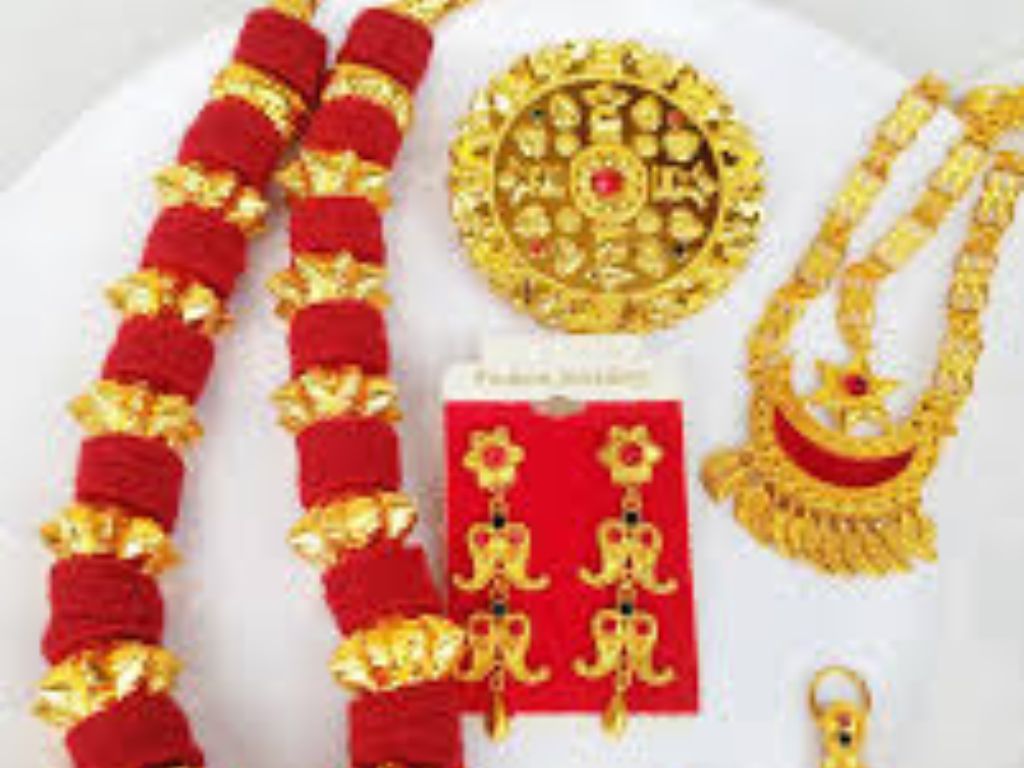
Tamang Jewelry Collections
The Tamang community, one of Nepal’s largest indigenous groups, has a rich tradition of jewelry that reflects their Tibeto-Burman heritage and Buddhist beliefs. Tamang jewelry combines Tibetan influences with unique indigenous styles, serving both decorative and spiritual purposes.
One of the most distinctive pieces is the Mathi, a star-shaped bracelet symbolizing cosmic forces. Women also wear Chyap, finger rings with engraved protective motifs, and Nhabi Mhar, elaborate ear ornaments that display artistic patterns. Tamang jewelry uses silver, gold, copper, and semi-precious stones, crafted with traditional metalworking and engraving skills passed down for generations. Many pieces feature Buddhist symbols, mantras, and protective elements. These ornaments continue to express Tamang identity, mark rituals, and preserve cultural heritage in modern Nepal.
| Categories | Name | Description |
|---|
Head and Hair Ornaments | Ting Mar, Dhungri, Yhapta Goli, Bulaki, Taari | Ting Mar, also known as Siripati, is a large silver forehead ornament with sun, moon, or Buddhist designs with red coral in the middle, usually surrounded by bits of dangling beads. Dhungri, or Chandra, is a crescent-moon-shaped silver ornament worn on the side of the head. Yhap ta Goli, or Kanzu, are heavy silver earrings that are spherical or cylindrical, often decorated with coral and turquoise. Bulaki is a gold or silver nose ring, sometimes made with a small dangling bead. Taari is a beaded necklace often incorporating glass, coral, and turquoise beads. |
| Neck Ornaments | Yhampa, Prubung, Ga’u | Yhampa (Kantha) is a broad silver necklace designed with dragons, phoenixes, and Buddhist symbols and often crafted with coral and turquoise so that it can symbolize wealth and status. Prubung (Duguri) is a multi-strand necklace of silver, coral, amber, and turquoise that is commonly worn with the Yhampa. Ga’u is a silver amulet box, worn as a pendant, containing the wearer’s mantras, relics, or herbs for protection. Sey is a necklace usually made from old silver coins, which is thought to protect the wearer. |
| Rings and Hand Ornaments | Auras, Dhungru, Angu | Auras are thick silver bangles that women wear in groups on their wrists. Dhungru are fancier bracelets, often decorated with designs or colorful stones. Angu are large silver rings, the most popular being the coin ring. |
| Ear and Nose Ornaments | Dhungri, Yhapta Goli, Bulaki | The Dhungri (Kaan ko phul) is a big silver disc-shaped earring made with a coral center and Buddhist designs, representing identity and status. The Yhapta Goli (Goli) is a cylindrical silver earring sometimes decorated with coral and turquoise, representing beauty and tradition. The Bulaki (Nathī) is a simple gold nose ring, sometimes with a bead, worn by married women as acknowledgment of status and wealth. |
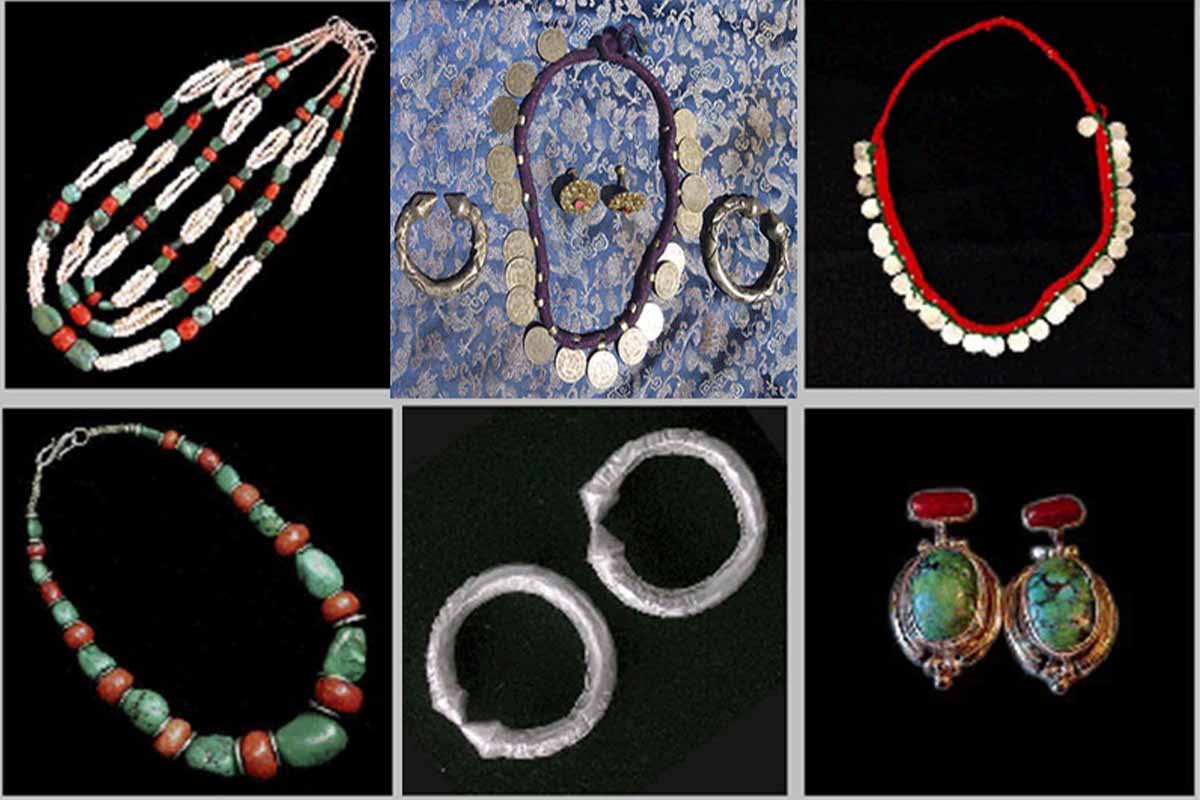
Rai and Limbu Jewelry
The Rai and Limbu communities of eastern Nepal, both part of the Kirat group, have a rich tradition of bold and elaborate jewelry that reflects their culture, spirituality, and social identity. Unlike the simple ornaments of Brahmin and Chhetri women, Rai and Limbu jewelry is large and statement-making, often passed down as heirlooms.
The most distinctive piece for Rai women is the Sirphul, a gold forehead disc engraved with protective and celestial designs. Limbu women wear the Sirbandi or Sesephung, a crescent moon-shaped forehead ornament symbolizing grace and divine feminine energy. Large gold Dungri ear studs and flat round Chaptesun earrings highlight their preference for prominent styles. The bold Bulaki septum ring adds dramatic beauty during festivals, while necklaces like the Chandrahaar and Purbeli Kantha Mala connect wearers to lunar worship and Kirat spirituality.
| Categories | Names | Description |
|---|
Head and Hair Ornaments | Sirbandi, Sirful, Juntara, | Sirbandi is a forehead ornament, placed above the center of the hair partition with a pendant that rests against the forehead. Sirful is another ornament that can be round or floral in shape, which adorns the center of the hair partition to beautify the hairstyle. Juntara is a chain-like ornament that connects the hair or ear to the nose ring (nath), which the bride traditionally wears, signifying beauty and culture. |
| Neck Ornaments | Puwalo, Kanthamala, Hamel | Puwalo is a necklace made of small gold beads strung together, often layered to create a striking look. Kanthamala is a heavy necklace, usually crafted from larg,e round beads of gold or silver, worn close to the neck. Hamel is a longer necklace made from flat or cylindrical pieces of silver or brass, giving it a bold appearance |
| Rings and Hand Ornaments | Kadechura | Kadechura is a bracelet that looks like a small thorny or spiky ring, usually made of silver or gold |
| Ear and Nose Ornaments | Godawari, Marwadi, Yarling, Cheptesun, Mundri, Fuli, Bulaki | Godawari is a decorative nose ring, usually made of silver or gold with stones or pearls. Marwadi is thick, bold gold earrings, and yarling is a traditional earring worn by Limbu, Magar, and Thami married women, and is usually made of gold-plated brass. Cheptesun is a pair of gold earrings from the Tamang community, which features hammered crescent designs. Mundri is a gold earring that is distinguished by its shapes and rich designs. Fuli is a small nose pin, and bulaki is a hanging nose ornament extending from the septum to the upper lip. |
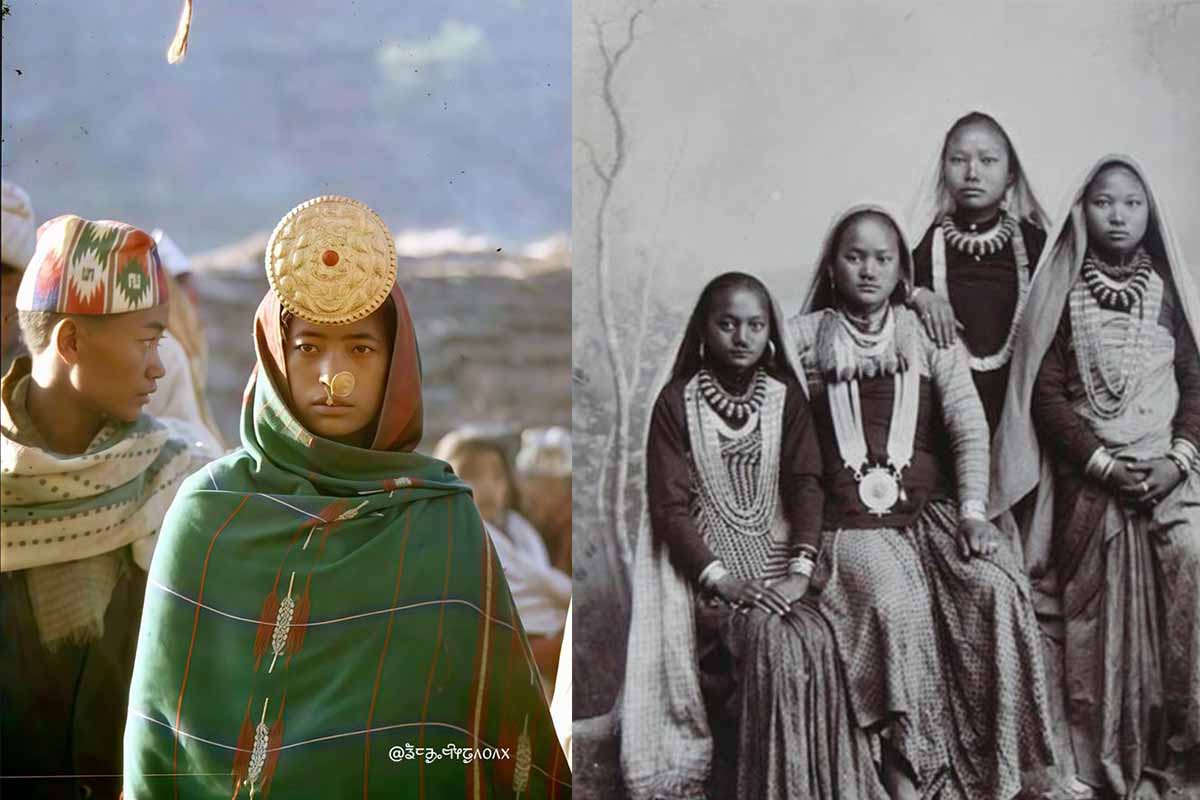
Sherpa and Tibetan-Style Jewelry
The Sherpa and Tibetan communities have their own unique style of handmade jewelry honoring their faith as Buddhists and their heritage to the Himalayan region. Their jewellery is extremely colorful and bold and is highly symbolic, containing turquoise, coral, dzi beads, and silver. The most important gem is turquoise and it denotes the sky as well as protection over spiritual belief. Coral is representative of the power of life and vitality. Sherpa coral is a bright red glass or bead found in Nepal and is used to help balance turquoise in necklaces and earrings.
The dzi bead is a sacred amulet, most specifically one of eye patterns, and is known for bringing fortune and warding off any negative activity against the wearer wearing the two beads inside an ornamental necklace or earring. The gau prayer box is a silver pendant that serves as a storage for sacred texts or images. The wearer relies on a gau necklace to carry spiritual blessings or good fortune with them. Both men and women wear Sherpa and Tibetan ornaments. However, women tend to wear more elaborate types of layers to represent fortitude, devotion, and identity, while men wear only a few layers and ornament style tends to represent wealth.
| Categories | Names | Description |
|---|
Necklaces and Malas | Kantha, Mala Beads, Turquoise Mala, Coral Mala, Amber Mala, Rudraksha Mala, Bodhi Seed Mala, Crystal Mala, Yak Bone Mala | Kantha is a multi-strand, colorful bead necklace worn in layers. It commonly combines turquoise, coral, and other sacred materials. Mala Beads are traditional prayer beads of 108 beads for meditation purposes, chanting, and counting mantras in the Buddhist tradition. Turquoise Mala is made entirely from turquoise stones, which represent the infinite sky and its healing energy. Coral Mala is made out of coral beads and symbolizes life force, vitality, and protection from negative energies. Amber Mala is made from fossilized resin of ancient organisms, and symbolizes wisdom, purification, and connection to the energies of the earth. Rudraksha Mala is made of sacred seeds believed to create a successful meditation and enhance spiritual growth. Bodhi Seed Malas are made of seeds from the bodhi tree, symbolizing enlightenment and the Buddha's awakening. Yak Bone Mala is made from carved Yak bone. |
Head and Hair Ornaments | Perak, Tibetan Hair Ornaments, Turquoise Hair Pins, Silver Hair Chains, Ceremonial Headpieces, Hair Rings, Braided Hair Jewelry, Temple Hair Ornaments | Perak is a multi-faceted turquoise-studded headdress that is used by married women, in particular Ladakhi and some Sherpa communities. Turquoise Hair Pins are ornamental items used to hold and decorate traditional-haired braids with turquoise stones. Silver Hair Chains are fine chains worn in the hair, having many points of connection for ornamental reasons. Ceremonial Headpieces are elaborate pieces of jewelry containing more than one gemstone that are worn in religious festivals and special ceremonies. |
| Ear Ornaments | Tibetan Silver Earrings, Turquoise Drop Earrings, Coral Cluster Earrings, Hoop Earrings, Chandelier Earrings, Buddhist Symbol Earrings, Large Statement Earrings, Hook Earrings | Large Statement Earrings are big silver earrings with turquoise and coral. Buddhist Symbol Earrings include sacred designs like endless knots, lotus flowers, and dharma wheels, usually crafted in silver. Chandelier Earrings are multi-tiered, dangling earrings with strands of beads, chains, and gemstones that create a dramatic, flowing look. |
Ceremonial & Wedding Jewelry | Bridal Turquoise Sets, Ceremonial Necklaces, Festival Jewelry, Temple Jewelry, Ritual Ornaments, Wedding Headpieces, Blessing Jewelry, Sacred Ceremony Sets | Bridal turquoise sets are complete wedding jewelry sets that include matching turquoise and coral jewelry worn by brides. Festival jewelry consists of special ornaments worn by the people of Ladakh during particular religious festivals like Losar, and other significant celebrations. Temple jewelry is sacred jewelry used during important religious ceremonies and on temple visits; it is commonly blessed by the lamas. Silver chain belts are decorative waist chains made of silver links that are meant to complete the traditional dress. |
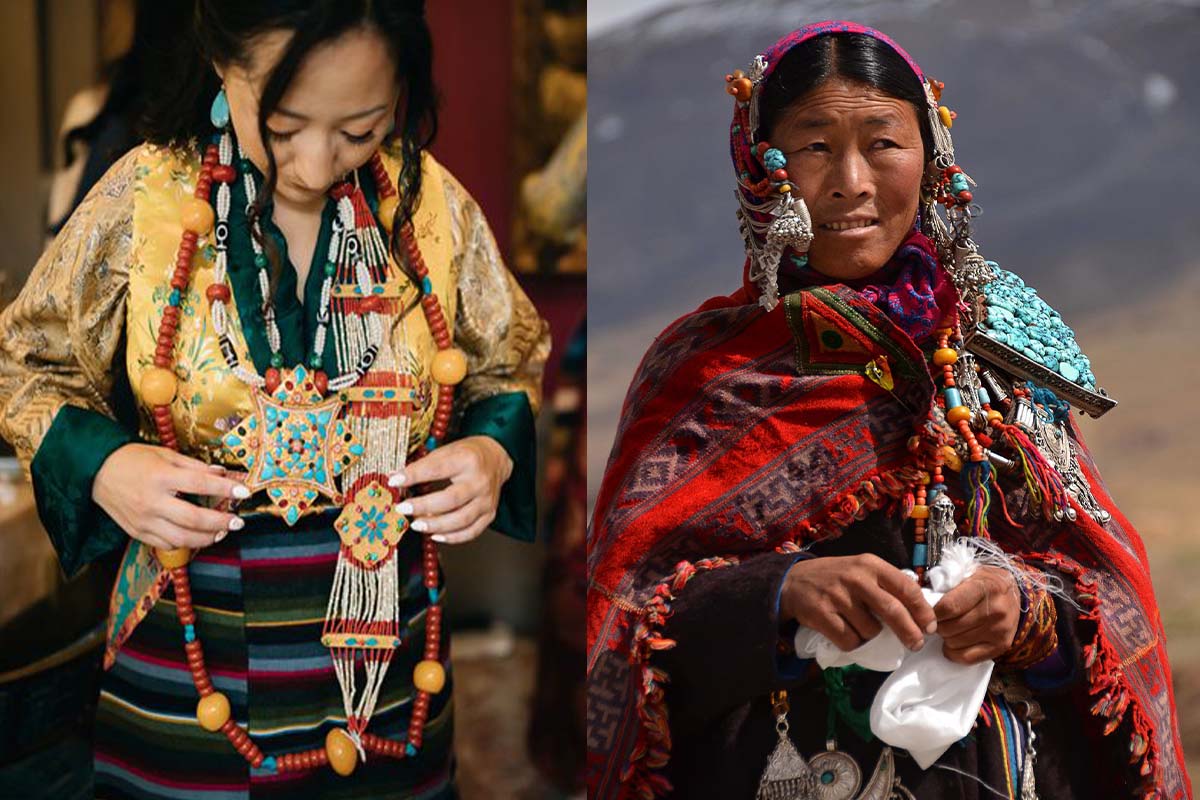
Brahmin and Chhetri Jewelry
The Brahmin and Chhetri communities in Nepal maintain a unique jewelry tradition related to the social and religious beliefs of these communities in Nepal. Women are typically decorated with simple ornaments that are more symbolic than decorative. The Pote, Tilhari, and Phuli are important ornaments in their communities. The Pote Necklace is worn by married women, which is given by husbands to their brides, as a symbol of married life and prosperity. These communities generally use gold, silver, and glass beads for their jewellery. Each piece of jewelry is handmade by local artisans, often using traditional means.
| Categories | Name | Description |
|---|
Head Ornaments | Sirbandi, Chandrama | Sirbandi is a forehead jewelry on the middle parting of hair with a pendant on the forehead. Chandrama is a crescent-shaped ornament on the hair/forehead, usually for an occasion. |
| Neck Ornaments | Company Mala, Poety, Chadkey Tilhari, Naugedi | Company Mala is a necklace with silver coins, the coins being stacked one over another. Poety is normally a traditional necklace made of beads or pieces of metal, usually glass beads. Chadkey Tilhari is a necklace with decorative pendants worn by married women. Naugedi is a nine-strand neck jewelry worn during festivals or rituals. |
| Nose Ornaments | Puli, Bulakhi, Jhumke Bulaki, Nathiya | Puli is a tiny nose stud or pin. Bulakhi is a hanging nose ornament from the septum. Jhumke Bulaki is a decorative septum ring with dangling designs. Nathiya is a large traditional nose ring that is mostly worn by brides. |
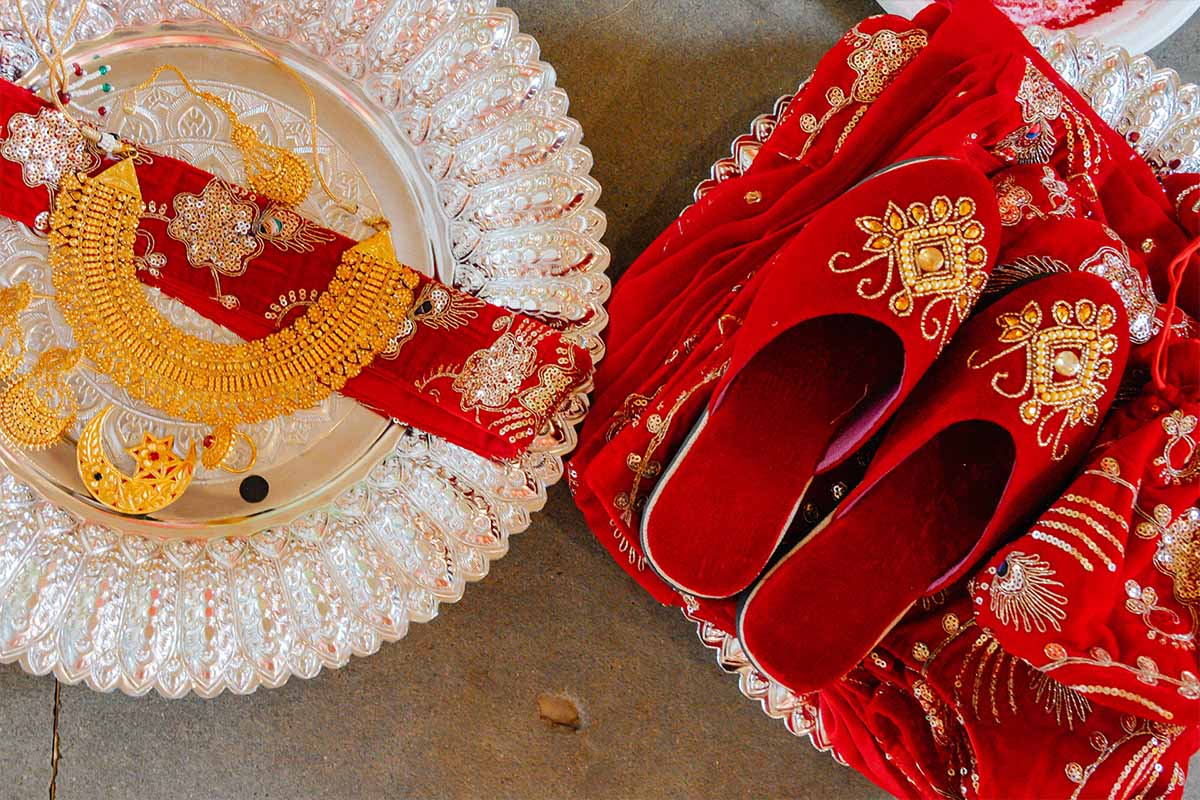
Tharu Jewelry Traditions
The Tharu community is famous for wearing traditional jewelry that is distinctive of Nepal, and it often consists of silver and white metals instead of gold. Silver has always been recognized in Tharu culture because it was affordable, more available, and matched Tharu women's skin tone. The jewelry is worn in large amounts and includes heavy necklaces called housali that can weigh up to several kilograms, thin anklets called chharra, thick armbands called barhari or katri, and rings called aunthi. The most interesting piece is the Tharu Coin Mala, which includes twenty-one silver coins representing inheritance and unity. These ornaments are examples of handmade jewelry of Nepal, decorated with floral, animal, and geometric designs. Beadwork using glass, seeds, shells, and bones contributes color and meaning.
| Categories | Names | Description |
|---|
Head Ornaments | Mangiya, Kilipha, Kanta, Phulara Choti, Maniya, Senura, Tikuli, Dhari, Tikka, Ali Band | Mangiya is a thick, rounded silver piece that sits on the hair. Kilipha is a flat, rectangular, or leaf-shaped ornament placed along the hair for decoration, while Kanta is a long, thin silver piece with small engravings worn along the hair parting. Phulara Choti is designed like a small silver flower, and Maniya is a tiny, rounded or leaf-shaped hair accessory. Senura is a thin, curved piece that fits along the hairline or forehead, and Tikuli is a small circular silver disc placed at the center of the forehead. Dhari is a narrow, curved silver ornament resting neatly on the hair, Tikka is a pendant-style ornament hanging from the middle parting onto the forehead, and Ali Band is a silver or metal band worn across the forehead to hold the hair in place. |
| Nose Ornaments | Nathiya, Nathuni, Phophi, Phuliya, Bulaki, Kenpi, Nasaaandkhila, Phuli | Nathiya is the largest nose ring, typically ornamental, and is typically worn by brides and other women on special occasions. Nathuni and Phophi are smaller nose rings and studs. Phuliya and Phuli are floral types of nose pieces. Bulaki is a hanging piece that attaches to the septum, and Kenpi is a nose ornament that is golden. Nasaaandkhila is another type of traditional nose piece, usually smaller and simpler, and is also worn in religious offerings. |
| Ear Ornaments | Sehari, Jhumka, Kanphul | Sehari refers to general ear decorations that complement other jewelry sets. Jhumka are traditional dangling earrings, often bell-shaped and ornate. Kanphul are flower-shaped earrings worn on the ears. |
| Ankle and Foot Ornaments | Payal, Upairi, Motha, Tadia | Payal are silver or metal anklets, sometimes with small bells that jingle as you walk. Upairi is a thicker, solid anklet worn close to the ankle. Motha is a wider style anklet, and Tadia is used for any toe ring small ornament worn on the feet. Payal are silver or metal anklets, sometimes with small bells that jingle as you walk. Upairi is a thicker, solid anklet worn close to the ankle. |
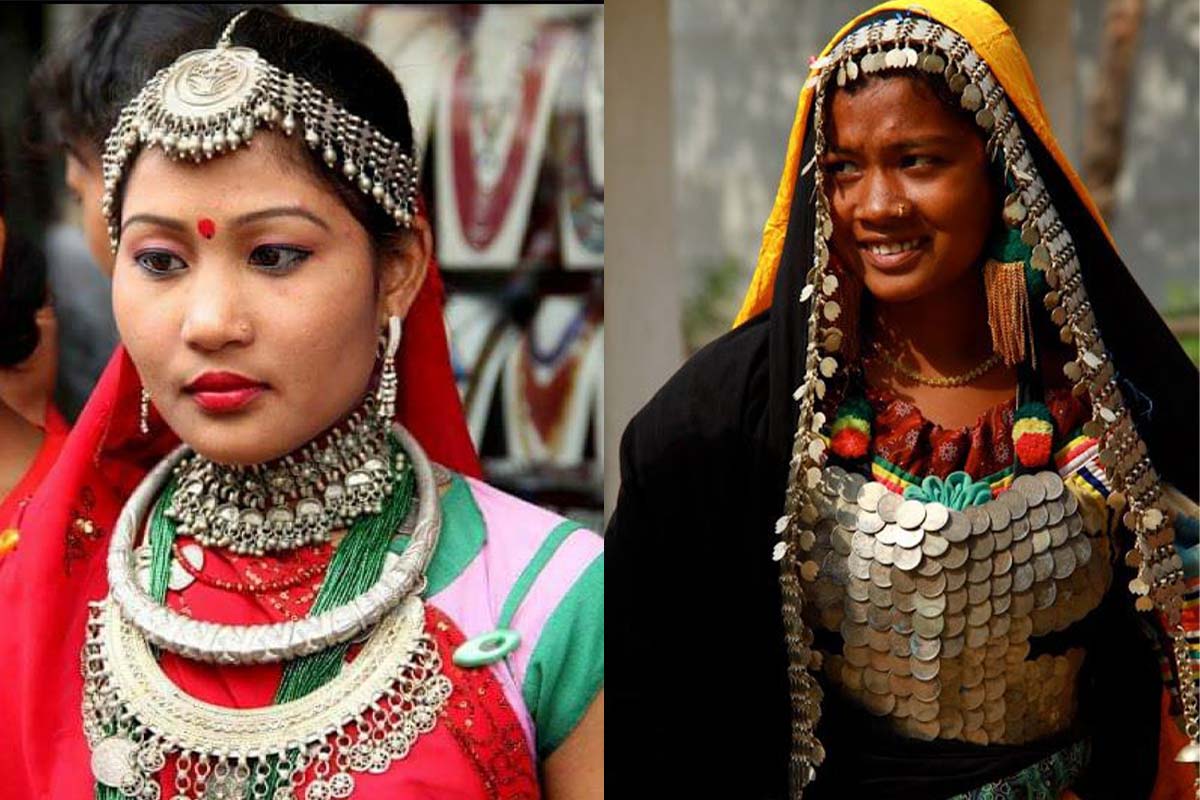
.jpg)

.jpg)







